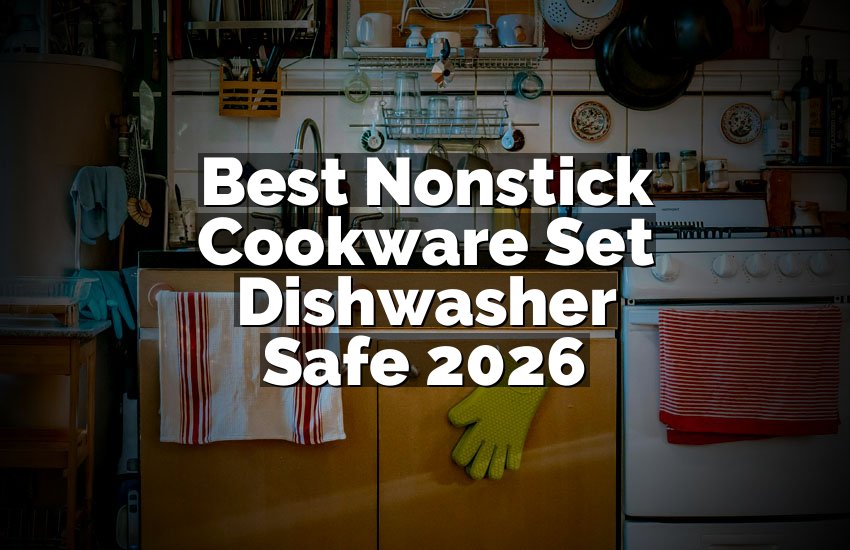As an Amazon Associate, I earn from qualifying purchases at no extra cost to you.
KitchenAid Dishwasher Hums But No Water (Fix It Fast)
Have you ever turned on your KitchenAid dishwasher, only to hear a humming sound and see no water inside? It’s so frustrating! I’ve been there, and I found out that this usually happens because the water can’t get into the dishwasher. In this article, I will explain easy ways to fix this problem so your dishwasher works perfectly again.
Check The Water Supply to Your Dishwasher
The first thing you need to do is check if your dishwasher is getting water from the main supply. Sometimes, the water valve that brings water to the dishwasher might be closed or blocked. This can cause the dishwasher to hum but not fill with water.
Start by locating the water supply valve under your kitchen sink. Turn it off and then on again to make sure it’s open. If you feel resistance or it’s stuck, try to gently turn it with pliers but be careful not to break it. Also, check the water hose connected to the dishwasher. Make sure it is not bent, kinked, or damaged. A blocked hose stops water flow.
If you have good water pressure in your home but the dishwasher still does not get water, it might mean the hose inside the dishwasher is clogged. You can remove the hose and clean it by flushing water through it. Sometimes small debris or food bits block water from entering.
If everything looks fine and water still doesn’t flow, the problem might be with the dishwasher’s water inlet valve. This valve opens to let water in when the dishwasher needs it. If it’s broken or clogged, the dishwasher will hum but no water will come in. You can check the valve for any dirt or damage and replace it if needed.
- Make sure the water valve under the sink is fully open
- Check the water hose for bends or damage
- Clean the hose if blocked
- Inspect and clean the water inlet valve
- Replace the water inlet valve if broken
Inspect The Water Inlet Valve For Problems
The water inlet valve is a very important part of your dishwasher. It controls the water flow inside your dishwasher and lets water in when the machine starts. If this valve is not working, you will hear a humming noise because the dishwasher motor is running but no water enters.
To check the valve, first unplug your dishwasher from the power source for safety. Then, find the water inlet valve at the bottom or back of your dishwasher. It looks like a small box with wires and a hose attached.
Look for any signs of damage or dirt. Sometimes small particles can clog the valve, stopping water from passing through. Clean the valve with a soft brush or cloth. If the valve looks damaged or worn out, you will need to replace it.
To be sure if the valve is broken, you can test it with a multimeter. This tool checks if electricity passes through the valve’s coil. If the valve doesn’t have continuity, it means it’s broken and must be replaced.
Replacing the water inlet valve is usually not very hard. You just need to disconnect the water hose, wires, and screws holding it in place. Then, install the new valve by reversing these steps. Always check your dishwasher manual or ask for help if you’re not sure.
- Unplug dishwasher before checking
- Locate the water inlet valve
- Clean any dirt or debris on valve
- Use a multimeter to test valve’s electrical function
- Replace the valve if it is broken or clogged
Clean And Check The Float Assembly
The float assembly in your KitchenAid dishwasher helps control the water level inside. It tells the machine when to stop filling with water. If the float is stuck or dirty, your dishwasher might not fill with water and just hum instead.
The float looks like a small plastic dome or cylinder inside the dishwasher tub, usually near the front or side. To check it, open the dishwasher door and find the float. Try to lift it gently with your finger. It should move up and down easily.
If the float is stuck in the “up” position, the dishwasher thinks it already has enough water and won’t fill more. Dust, soap scum, or food pieces can make the float sticky or stuck. Clean around the float using warm water and a soft cloth or toothbrush. Make sure it moves freely after cleaning.
Sometimes the float switch, which works with the float, can be broken or faulty. This switch tells the dishwasher to stop filling when the float rises. If the switch doesn’t work, the dishwasher won’t fill with water. You can test the switch with a multimeter or ask a technician to help.
- Locate the float assembly inside dishwasher
- Check if the float moves freely up and down
- Clean the float and surrounding area
- Test or replace the float switch if needed
Look For Blockages In The Spray Arms And Filters
Blocked spray arms or filters can cause your dishwasher to not work properly. While this problem usually affects cleaning, it can also stop water from flowing correctly inside the dishwasher, making it hum without filling.
The spray arms are the parts that spin and spray water on your dishes. They have small holes that can get clogged by food, hard water, or soap buildup. To clean them, remove the spray arms carefully. You can usually pull or unscrew them.
Use a toothpick or a small brush to clear out any dirt or blockages from the holes. Then, rinse the arms with warm water to wash away loosened debris. Make sure the arms spin freely when you put them back.
Filters are found at the bottom of the dishwasher and stop food from going into the drain. If filters are dirty or blocked, water flow can slow down or stop. Remove the filter and clean it well under running water with a soft brush.
Keeping these parts clean helps water flow smoothly, so your dishwasher fills and cleans dishes well.
- Remove and clean spray arms
- Clear all holes of dirt and buildup
- Clean dishwasher filter regularly
- Check spray arms spin freely after cleaning
Test The Door Latch And Switch
Your dishwasher will not start filling with water if the door latch or door switch is not working right. The dishwasher needs to know the door is closed properly before it begins.
The door latch is the part that keeps the dishwasher door tightly closed. If it’s loose or broken, the dishwasher might hum but not work. Also, the door switch senses when the door is closed and tells the machine to start the cycle.
If the door latch is broken or not locking well, try adjusting or replacing it. You can usually see if the latch is damaged or cracked by looking carefully.
To check the door switch, unplug the dishwasher and use a multimeter to test for continuity. If the switch does not work, the dishwasher will not get a signal to start filling water. In that case, you will need to replace the switch.
- Check if door latch locks door tightly
- Adjust or replace broken door latch
- Test door switch with multimeter
- Replace faulty door switch
Reset The Dishwasher Control Board
Sometimes, the dishwasher’s control board can have errors that make the machine hum but not fill with water. Resetting the control board can fix many problems and make your dishwasher work again.
To reset, first turn off your dishwasher and unplug it from the power outlet. Leave it unplugged for about 5 minutes. This helps clear any electrical issues or glitches inside the machine’s brain.
After waiting, plug the dishwasher back in and turn it on. Try starting a new cycle and see if it fills with water now.
If resetting does not work, your control board may be damaged or faulty. In this case, it might need to be replaced. This is more complicated, so you can call a professional repair person.
- Turn off and unplug dishwasher
- Wait 5 minutes before plugging back in
- Start a new cycle to test
- Replace control board if problem remains
Final Thoughts
A KitchenAid dishwasher humming but not filling with water is a common and fixable problem. Most times, it’s caused by a blocked water supply, faulty water inlet valve, stuck float, or door issues. By carefully checking each part and cleaning or replacing what’s broken, you can solve this problem without much stress. Always unplug the dishwasher before working on it, and if you are unsure, ask for help from a professional.
| What To Do | How To Check Or Fix |
|---|---|
| Water supply valve | Make sure it’s open and hose is not blocked |
| Water inlet valve | Clean or replace if broken |
| Float assembly | Clean and make sure float moves freely |
| Spray arms and filters | Remove and clean to clear blockages |
| Door latch and switch | Check latch locks and test switch with multimeter |
| Control board | Reset by unplugging or replace if faulty |
Frequently Asked Questions (FAQs)
Is it normal for a dishwasher to hum without filling water?
Yes, it is common for dishwashers to make a humming noise when the motor runs but water does not enter. The humming sound means the dishwasher is trying to work, but a part like the water inlet valve or float assembly might be blocking the water. Fixing these parts usually solves the problem.
Can I fix a stuck float assembly by myself?
Yes, cleaning and moving the float assembly is easy and safe to do yourself. Just open the dishwasher door, find the float inside, and clean it with warm water and a soft brush. Make sure it moves up and down freely. If it still doesn’t work, the float switch might need professional checking.
Do I need special tools to check the water inlet valve?
You will need a multimeter to test the electrical function of the water inlet valve. This tool is inexpensive and easy to use for basic tests. If you don’t have one, you can visually inspect the valve for dirt or damage and clean or replace it if needed.
Is it possible that the door latch is causing no water fill?
Yes, if the door latch is broken or loose, the dishwasher won’t start the water fill cycle because it thinks the door is open. Checking and fixing the latch is important for the dishwasher to run properly.
Can a blocked spray arm stop water from filling?
While blocked spray arms mostly affect cleaning, severe blockages can cause water flow problems inside the dishwasher. Cleaning the spray arms and filters helps the dishwasher work better, but the main water fill issue usually comes from valves or float parts.
Do I need to reset the control board often?
No, resetting the control board is only needed if the dishwasher has electrical glitches. It’s not something to do regularly but can help fix strange problems like humming without water. If resetting doesn’t work, the control board may need replacement.
Is it safe to work inside the dishwasher?
Yes, it is safe if you unplug the dishwasher first. Always disconnect power before touching any parts to avoid electric shock. If you’re not comfortable working on appliances, ask a professional technician for help.
Can low water pressure cause my dishwasher not to fill?
Yes, low water pressure in your home can stop water from entering the dishwasher. Check if other faucets work well. If water pressure is low everywhere, you may need to call your water supplier or plumber.




